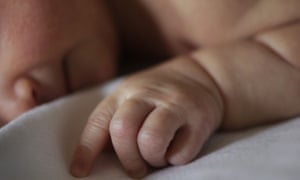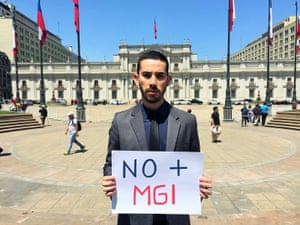Originally published in The Guardian on 10/02/2016. Available at: https://www.theguardian.com/global-development-professionals-network/2016/feb/10/intersex-human-rights-lgbti-chile-argentina-uganda-costa-rica
A landmark directive in Chile last month said doctors should stop ‘normalisation’ surgery, but tackling the global systematic, societal and cultural abuse against intersex people is an uphill battle

“The surgeon’s approach was that I didn’t identify as a woman because I didn’t have a vagina,” says Mauro Cabral. After growing up in Argentina being treated as a girl, he discovered at the age of 14 that he didn’t have any internal female organs. Although he had always felt male, and still does, he was forced to undergo surgery to create a vagina.
“I’m still trying to understand what has happened and how to recover my life,” says Cabral, now an intersex and trans activist and co-director of Gate. “My experience is very similar to those who have suffered torture – when they try to speak, their societies and even families are not prepared to hear what happened.”
For about one in 2,000 people binary notions of male and female are particularly problematic. Research has found between 0.05% and 1.7% of the global population (pdf) are born with intersex traits – biological sex characteristics that don’t conform to typical notions of male or female. The upper estimation is around the same number of red haired people, yet intersex people are far less visible.
There are at least 40 intersex variations, ranging from genetic, chromosomal, anatomic and hormonal. In countries with access to western healthcare, it has become common practice to subject intersex children to medical interventions to make their bodies fit into the male/female binary, with damaging results.
Last month a landmark directive on intersex rights was announced by the government of Chile. The ministry of health issued guidance to stop “normalisation” surgeries on intersex children. It is one of two countries in the world that has produced any formal guidelines preventing these medical interventions. The other is Malta, which in April 2015, was the first country to prohibit these surgeries by law.
Known as the “I” in LGBTI, intersex people are often placed under the umbrella of campaigns for gender and sexual orientation rights. But activists are keen to state the difference: they face discrimination due to biological differences, and intersex people can be heterosexual, or same-sex attracted, or might transition, just like anyone else.

The recent progress in Chile, where there was virtually no intersex movement, is hugely significant. Camilo Godoy Peña, the 26-year-old Chilean human rights defender who was a lead promoter of the new guidance is not intersex himself but has a “love for human rights”. He says that in Chile, which was under dictatorship for 17 years, the word “torture” has a lot of power. “When you say that this kind of treatment under the consent of the state could be torture, it’s really big.”
Godoy Peña is encouraging human rights activists all over the world to use the milestone in Chile to call on their own ministries of health to issue guidelines to help intersex people. “It’s the highest standard of human rights,” he says.
Evidence that the standard medical interventions developed in the US in the 1950s – surgery on babies or children, hormone treatment and ensuring children adhere to gender norms – are damaging has fuelled the calls for new approaches to intersex children.
“In many cases the interventions are the same as female genital mutilation, clitoral reduction or other forms of clitoris cutting – and other interventions on boys as well,” says intersex activist and president of Organisation Intersex International Australia, Morgan Carpenter. “They’re obviously human rights violations. There’s this focus on our genitals, rather than a focus on us as individuals.”
In rural or poorer communities where surgeries are not an option, discrimination comes in other brutally violent forms. According to Julius Kaggwa executive director of SIPD Uganda, an organisation that advocates for intersex rights: “In many African countries, the traditional way of dealing with perceived sexuality ‘abnormalities’ has largely been staying silent – and wishing them away through various kinds of traditional rituals, which often meant killing the intersex infants.”
This stigma is prevalent throughout the continent. In rural Malindi, Kenya, 17-year-old Muhadh Ishmael was born with both male and female genitalia. He was brought up as a girl, but always identified as a boy, which his family could not accept. In December last year, a group of men, thought to be hired by his uncle, drugged him and cut off his penis. He died from his injuries.
Kaggwa says that compared to funding the fight against homophobia or the plight of child soldiers in Africa, “complete indifference [is shown] to life-threatening genital mutilations and infanticide that intersex children suffer”.

Tackling the systematic, societal and cultural abuses against intersex people, the global movement for intersex rights has been an uphill battle. Not only is it a very poorly-funded movement, but there is a global lack of knowledge and understanding; the UN high commissioner for human rights, Zeid Ra’ad al-Hussein, even admitted he knew little about intersex people before he started his role. Cabral believes “it’s not that intersex people are not speaking, but that the non-intersex people are not listening”.
However, this seems to be changing. “The intersex movement is consolidated and strengthened, and intersex voices are rising up and fighting for their rights,” says Costa Rican intersex rights activist Natasha Jiménez. “This will help us to see more initiatives of this kind around the world.”
There are signs of hope. In Uganda, Kaggwa says that through engagement some local leaders are becoming more empathetic to intersex issues. In 2013, Brujula Intersexual formed to provide a meeting point for Latin American intersex people and information in Spanish. Last year, the UN released a report that condemned violence (doc) against intersex people, and in September 2015, the UN met for the first time to discuss intersex rights.
“Intersex activism is focused on the future,” Cabral says. “There’s not much that we can change about our own lives, but we want to prevent other people from going through the same processes. I hope for full recognition of intersex as a human rights issue. We want to believe that once you tell the truth, people are going to react in the ethical way.”
From 8-14 February the Guardian Global Development Professionals Network is highlighting the work of the LGBT rights activists throughout the world. Join the conversation at #LGBTChange.
Join our community of development professionals and humanitarians. Follow @GuardianGDP on Twitter.
